Is the 12.7 mm/.50cal Heavy Machine Gun (that will arm UK Boxers) enough firepower for a vehicle that will form the vehicular backbone of the British Army?
The M2 ‘Fifty Cal’ is an enduring design that has seen numerous attempts to replace it. Older than B-52, or even (whisper it) the FV432. Infrequently used in a dismounted role, users now generally have them in Remote Weapon Stations, and the UK is no different.
Boxer 50cal Background
Our RWS of choice is the Kongsberg Protector RS4, manufactured under licence by Thales in Glasgow.

The most recent £180m order was for 500 of them, together with the same number of Acusonic shot detection systems, the same as used on Ajax.
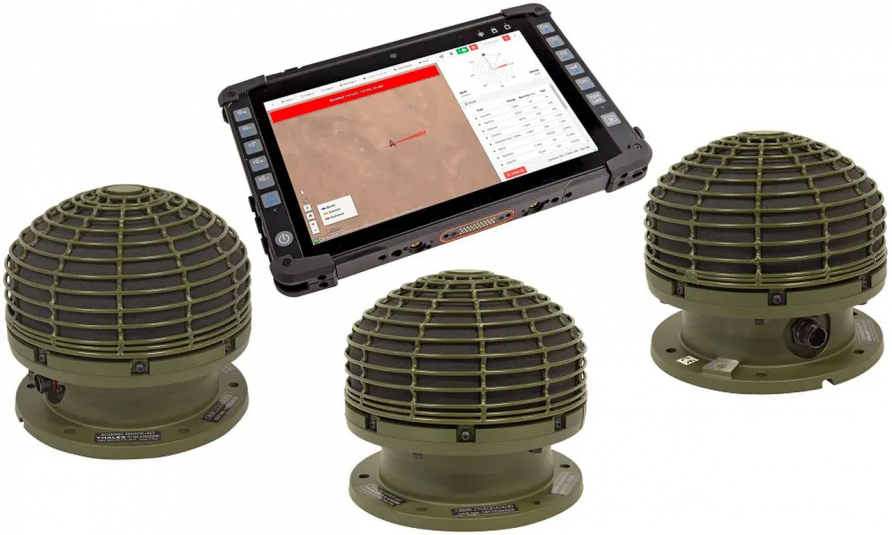
The RS4 is the latest iteration and is now fully GVA compliant, has multi-axis stabilisation, offers the ability to be remotely controlled from outside the vehicle and can be operated by multiple crew stations. A very clever piece of equipment that allows the maximum range of the mounted weapon to be fully exploited. It adds 135 kg of top weight, plus the weight of the weapon and its ammunition.
It will feature a Thales Catherine-EZ cooled thermal imager, Thales CELT3 laser rangefinder and Kongsberg VIS95 daylight camera.

Depending on one’s perspective, at over 50 kg plus 20 kg’s worth of ammunition is either too heavy or reassuringly solid. Many also remark that it lacks power for such a large vehicle and one that might encounter 14.5 mm or 23 mm armed adversaries.
Of course, many of these conversations tend to coalesce on individual weapons rather than concepts of employment for the Mechanised Infantry Vehicle (MIV). It is also fair to say that the enemy also gets a vote, and we might not always have the luxury of employing them as we wish. Ukraine has also provided a stark reminder that low-cost UAS can be devastatingly effective, even when armed with improvised weapons like free-fall mortar bombs with 3D-printed tail fins.
Thus, the target set is not just a technical with a 23 mm, it is a DJI drone with a mortar bomb.
Upgrade to a 20 mm Automatic Cannon
The mechanical simplicity of the M2 has much to commend it, recoil-operated and rock-solid. The faster firing M3 might be a quick-to-adopt option (they are already in service on Army Air Corps and Fleet Air Arm Wildcats) but it is difficult to see any advantages, the higher rate of fire suits perfectly a helicopter, but not a vehicle.
Going to something like a 20 mm automatic cannon might offer some advantages and a relatively easy upgrade path but it is not all plain sailing.
There are quite a few 20 mm automatic cannons still in production. The AE 20 mm or Alexis 20 mm weigh about the same as an M2, but have significantly more powerful ammunition.
The Alexis weighs 49 kg and has an effective range of 1,500m, with a selective rate of fire of 300 or 750 rounds per minute. It has TP Target practice, TP-T Target practice Tracer, AP Armour piercing, AP-T Armour piercing Tracer, HEI High explosive incendiary, and an MP Multi-purpose round.
The Nexter M621 is another example of a simple, recoil-operated, 20 mm automatic cannon, as is the Rheinmetall KAE.
The Nexter M621 has been recently selected by the German Army for special forces using a manually aimed ring mount.

The new Sky Viper from General Dynamics is also another interesting option.
20×113 mm, 20×128 mm and 20×139 mm ammunition manufactured globally with plenty of natures available.
Recoil forces would likely be higher, and the number of rounds carried, decreased.
Can the Thales/Kongsberg RS4 handle the increased recoil forces and is the juice with the squeeze?
On the former, I am not sure, although it is fair to say that the basic weights of an M2 and most of these 20 mm options are quite similar. Recoil compensation is quite a complex subject, which is a roundabout way of saying don’t know. But assuming it can, the most pressing question is an advantage versus cost and a reduced number of rounds carried. Effective range and terminal effects are certainly improved, but for the most likely target sets and requirements, are they that much of an improvement, again, one for discussion?
Their lack of effect against small drones would also have to be considered.
Just as an aside,
AEI has done a lot of work on recoil energy attenuation and some have claimed that the Venom 30 mm LR can be a direct drop-in replacement for 12.7 mm M2, shown below on a Valhalla Midgard RWS
Maybe with a look to see if it can be operated from an RS4?
Perhaps one thing to look at is the extended height turret that German Boxers deployed to Afghanistan with, designed to improve depression angles.

Fitting Javelin
This is a pretty easy upgrade.

As far back as 2016, the Armoured Trials and Development Unit (ATDU) conducted some trials with a Kongsberg Protector (RS4) mounted on a CVR(T) Spartan (image above). Five missiles were fired during the trials, three Block 0 missiles at 1,500m, 2,500m and 3,200m, and two Block 1 missiles at 3,500m and 4,300m.
All were successful.
The Thales promotional material states the RS4 is ‘Javelin Enabled’.
Javelin is already in service.
Not every module needs a Javelin, but it would be a quick and cheap option.
Air Bursting 40 mm HV Grenades
Although you see them less than the 12.7 mm Heavy Machine Gun in promotional materials, the Thales RS4 can also mount the 40 mm Grenade Machine Gun. With an ability to fire High Velocity 40 mm grenades, it could provide overlapping and complementary options to the 12.7 mm HMG, to a similar range.
The GMG does not have a dual feed capability, so any change in nature would require manual intervention, so dual-purpose natures seem to be the most common, available from many sources. So far, air-bursting 40 mm HV grenades do not seem to have entered widely into service, but options are certainly there. To enable this, a change to the weapon is needed, Nammo is marketing a product called the MPU that allows existing 40 mm AGLs to be quickly modified for their air-bursting natures.

Upgrading the software to exploit the possibilities of air-bursting 40 mm high-velocity grenades is also another factor to consider. Nammo used an H&K 40 mm GMG and an RS4 for their trials, so it doesn’t, on face value, seem, an impossibility.

Nammo 40 mm HEDP-RF is shown below.

Exploiting the newer air-bursting grenades, some interesting counter-UAS solutions are emerging, the Aselsan Atom and a similar product from Nammo/Escribano.
With an effective range of about 500m, these counter-UAS grenades have obvious limits, but then again, they use an existing weapon that is widely deployed and in service, something is better than the square root of nothing.
Part of a layered approach to the counter UAS problem, with offboard detection, seems worth looking at.
Upgrade the RWS and Go Large
If we want to go to 25 mm or 30 mm, options are available to open up the potential for air-bursting natures for effective counter UAS capability.
But this would mean upgrading the RWS.
The RS4 goes back some way and is part of a family of RWS that includes the much larger RT60.

Upgrading to the RS6 or something like the Moog RIwP might provide additional options, 20-30 mm automatic cannons, for example, take your pick, there are quite a few options, e.g. Nexter M781, General Dynamics M230LF or AEI Venom LR
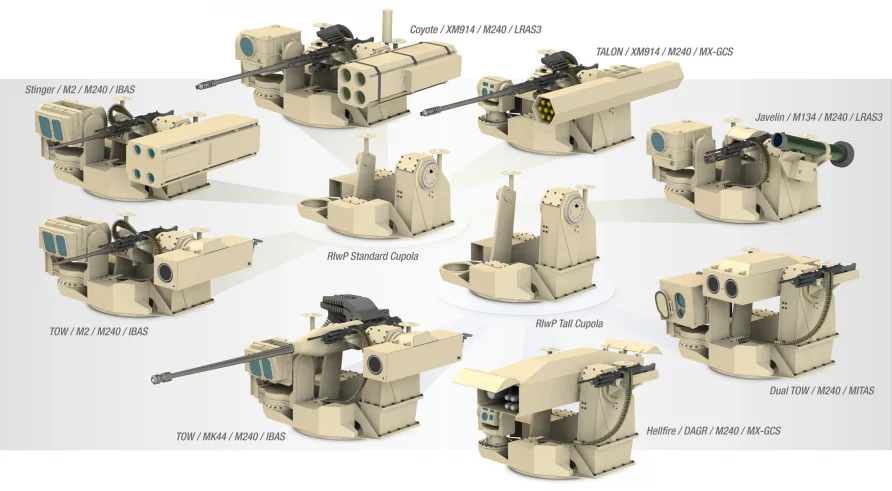
Perhaps, and this makes more sense to me than any other options, go 40mm CTAS in a RWS.
Any of these large RWS would significantly change the nature of Boxer, and that might be a conversation worth having, but not today.
A Few Thoughts
What have we learned from switching horses mid-course, what have we learned from changing requirements whilst still in the manufacturing stage?
The absolute very last thing we want to do is start modifying existing contracts, so any discussion must start with the RS4, at least for the bulk of Boxer vehicles (talking about more heavily armed support or recce variants is an entirely different conversation)
This means, in practice, two weapons for any improvements, the 40 mm Grenade Machine Gun, and the Javelin ATGW.
We have both in service.
Personally, I think it makes sense to look at Javelin and air-bursting natures for the 40 mm GMG and mix those with the 12.7 mm HMG, these are all proven weapons with integration either already done or simple enough on the RS4. Air bursting 40 mm also opens the door to a wider counter UAS capability.
Then, and only then, start to look at the sweets in the 30-40 mm shop.
Stay on course, get Boxer into service as planned, and maybe make a few tweaks to what we have planned, but no more. (we might already have these in the pipeline anyway)
To close, a picture of the RS4 with 12.7 mm HMG, on a Boxer, with a Javelin.
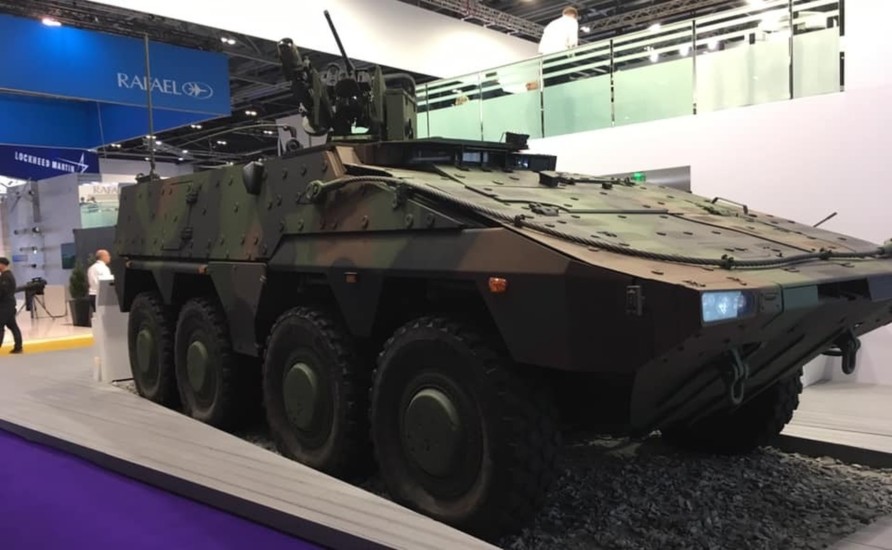
See you in the comments.
Discover more from Think Defence
Subscribe to get the latest posts sent to your email.


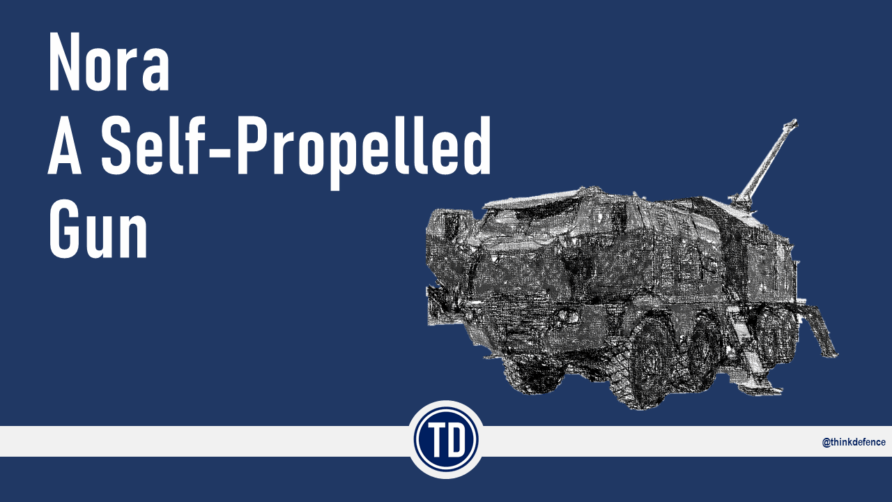
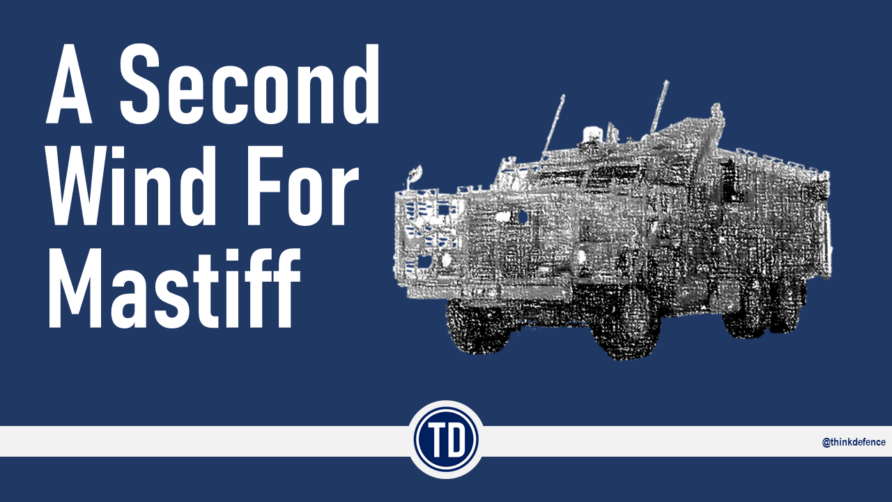
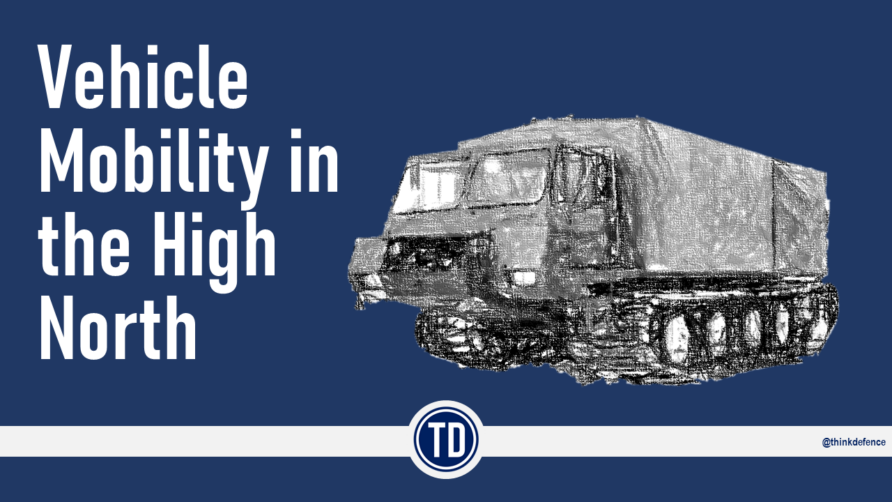
I’d figure every RS4 should be made Javelin capable and each platoon have a 2:2 mix of HMG & GMG.
Then we could look at giving the battalion anti-tank platoon Boxers with longer range ATGWs & autocannon in RT RWS later?
I’d be tempted to give the recce platoon autocannon & drone tubes RT RWS as well.
Good head-scratching article TD. I agree with keeping RS4 for now and adding Javelin to them. Down the road, once Ukraine ops have had a thorough going over and UK troops have had time to use Boxer, and figure out its good and bad points, see what the troops think it needs based on their experiences and what is seen in the crystal ball.
Can I be the first to suggest going smaller instead of going larger? How about levering the SIG High Pressure, Bi-Metal cartridge in .338 Norma Magnum in their Medium Machine Gun? A very high performance round before considering the SIG proprietary “High Pressure” rounds, but a little smaller and lighter than 12.7mm, so more rounds on mount but a similar range performance (perhaps even a little better?) than the venerable M2?
The other tweak I wonder about, is whether the laser guidance for LMM could be easily added to the RS4, a pair of LMM on so many vehicles per company is a big uplift in C-UAS (and anti-helo, maybe even anti-fast jet), and it also has good capability against light armour, bunkers etc, and a cheaper shot than a Javelin for taking out that Technical with a 23mm….???
Jed, if 20mm and 12.7mm are not effective against small drones as TD says, how would .338 fair any better? .338 would make a great “coax” but I don’t see it as a good option for a “main” gun. IMO an airburst round is needed to counter drones effectively which equal 40GMG/30x113mm at a minimum in my book. But again that’s down the road once Boxer is service and has been rung out by the troops.
One of the things I like about the RWS is the modularity of them, the ability to tailor the system with add on cannon and missiles to suit the need provided the starting point is correct. I would stick with the konsberg family and the Thales sensors as a start point, the need for as many vehicles as possible to have access to such sensor systems must be a lesson from Ukraine.
While initial deliveries should be for the rs4 I would like the rs6 to be added also, it would give some increased firepower options but would allow also us to leverage us marine corp development of that turret in the shorad configuration with possible integration of LMM missile for uk variants as an option in place of javelin. Think this will be important particularly in urban areas and would allow units to mix and match as required.
Would see plenty of scope for both in infantry units particularly is they adopted a commando 21 type set up of two close combat and two stand off configuration with the rs4 in the former and rs6 in the latter.
I don’t understand how a boxer with a .50 cal machine gun is meant to replace the 30mm cannon on the warrior, even with raden’s problems. Especially with how undermechanised the army is, I hope we see a reversal on the warrior decision soon now that there will probably be money for it.
LMM/Martlet is certainly an option that was displayed at DVD this year on the Thales stand. In terms of longer range anti-armour capability, MBDA is looking at Boxer-mounted Brimstone. Think of the CVR(T) Striker on steroids. A Brimstone-Boxer module was also at DVD.
"The absolute very last thing we want to do is start modifying existing contracts, so any discussion must start with the RS4, at least for the bulk of Boxer vehicles "
I don't understand this. Swapping out say 200 RS4 for RS6 – same supplier, just the next step up in the product family – should surely not be beyond the wit of man.
As you say, the enemy gets a vote, and Warrior is not long for this world. Swapping horses midstream may have applied to the infamous 1000 KURs pushed on to Ajax but Boxer is a mature platform and designed for modularity.
Regarding changing contracts, have you ever tried ordering something bespoke and then tried changing it? You’ll likely end up being charged for what you originally ordered AND the new stuff, then only get the new stuff.
Defence hardware isn’t like consumer goods.